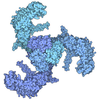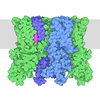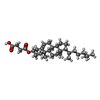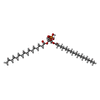+ Open data
Open data
- Basic information
Basic information
| Entry | Database: PDB / ID: 6aei | ||||||||||||||||||||||||||||||||||||
|---|---|---|---|---|---|---|---|---|---|---|---|---|---|---|---|---|---|---|---|---|---|---|---|---|---|---|---|---|---|---|---|---|---|---|---|---|---|
| Title | Cryo-EM structure of the receptor-activated TRPC5 ion channel | ||||||||||||||||||||||||||||||||||||
 Components Components | Short transient receptor potential channel 5 | ||||||||||||||||||||||||||||||||||||
 Keywords Keywords | MEMBRANE PROTEIN / Cryo-EM / mouse TRPC5 / ion channel | ||||||||||||||||||||||||||||||||||||
| Function / homology |  Function and homology information Function and homology informationregulation of membrane hyperpolarization / phosphatidylserine exposure on apoptotic cell surface / negative regulation of dendrite morphogenesis / TRP channels / inositol 1,4,5 trisphosphate binding / actinin binding / clathrin binding / positive regulation of axon extension / calcium channel complex / positive regulation of neuron differentiation ...regulation of membrane hyperpolarization / phosphatidylserine exposure on apoptotic cell surface / negative regulation of dendrite morphogenesis / TRP channels / inositol 1,4,5 trisphosphate binding / actinin binding / clathrin binding / positive regulation of axon extension / calcium channel complex / positive regulation of neuron differentiation / calcium channel activity / neuron differentiation / presynapse / positive regulation of cytosolic calcium ion concentration / actin binding / growth cone / ATPase binding / neuron apoptotic process / neuronal cell body / positive regulation of cell population proliferation / dendrite / plasma membrane Similarity search - Function | ||||||||||||||||||||||||||||||||||||
| Biological species |  | ||||||||||||||||||||||||||||||||||||
| Method | ELECTRON MICROSCOPY / single particle reconstruction / cryo EM / Resolution: 2.89 Å | ||||||||||||||||||||||||||||||||||||
 Authors Authors | Duan, J. / Li, Z. / Li, J. / Zhang, J. | ||||||||||||||||||||||||||||||||||||
 Citation Citation |  Journal: Sci Adv / Year: 2019 Journal: Sci Adv / Year: 2019Title: Cryo-EM structure of TRPC5 at 2.8-Å resolution reveals unique and conserved structural elements essential for channel function. Authors: Jingjing Duan / Jian Li / Gui-Lan Chen / Yan Ge / Jieyu Liu / Kechen Xie / Xiaogang Peng / Wei Zhou / Jianing Zhong / Yixing Zhang / Jie Xu / Changhu Xue / Bo Liang / Lan Zhu / Wei Liu / ...Authors: Jingjing Duan / Jian Li / Gui-Lan Chen / Yan Ge / Jieyu Liu / Kechen Xie / Xiaogang Peng / Wei Zhou / Jianing Zhong / Yixing Zhang / Jie Xu / Changhu Xue / Bo Liang / Lan Zhu / Wei Liu / Cheng Zhang / Xiao-Li Tian / Jianbin Wang / David E Clapham / Bo Zeng / Zongli Li / Jin Zhang /   Abstract: The transient receptor potential canonical subfamily member 5 (TRPC5), one of seven mammalian TRPC members, is a nonselective calcium-permeant cation channel. TRPC5 is of considerable interest as a ...The transient receptor potential canonical subfamily member 5 (TRPC5), one of seven mammalian TRPC members, is a nonselective calcium-permeant cation channel. TRPC5 is of considerable interest as a drug target in the treatment of progressive kidney disease, depression, and anxiety. Here, we present the 2.8-Å resolution cryo-electron microscopy (cryo-EM) structure of the mouse TRPC5 (mTRPC5) homotetramer. Comparison of the TRPC5 structure to previously determined structures of other TRPC and TRP channels reveals differences in the extracellular pore domain and in the length of the S3 helix. The disulfide bond at the extracellular side of the pore and a preceding small loop are essential elements for its proper function. This high-resolution structure of mTRPC5, combined with electrophysiology and mutagenesis, provides insight into the lipid modulation and gating mechanisms of the TRPC family of ion channels. | ||||||||||||||||||||||||||||||||||||
| History |
|
- Structure visualization
Structure visualization
| Movie |
 Movie viewer Movie viewer |
|---|---|
| Structure viewer | Molecule:  Molmil Molmil Jmol/JSmol Jmol/JSmol |
- Downloads & links
Downloads & links
- Download
Download
| PDBx/mmCIF format |  6aei.cif.gz 6aei.cif.gz | 461.5 KB | Display |  PDBx/mmCIF format PDBx/mmCIF format |
|---|---|---|---|---|
| PDB format |  pdb6aei.ent.gz pdb6aei.ent.gz | 381.2 KB | Display |  PDB format PDB format |
| PDBx/mmJSON format |  6aei.json.gz 6aei.json.gz | Tree view |  PDBx/mmJSON format PDBx/mmJSON format | |
| Others |  Other downloads Other downloads |
-Validation report
| Summary document |  6aei_validation.pdf.gz 6aei_validation.pdf.gz | 1.2 MB | Display |  wwPDB validaton report wwPDB validaton report |
|---|---|---|---|---|
| Full document |  6aei_full_validation.pdf.gz 6aei_full_validation.pdf.gz | 1.3 MB | Display | |
| Data in XML |  6aei_validation.xml.gz 6aei_validation.xml.gz | 82.7 KB | Display | |
| Data in CIF |  6aei_validation.cif.gz 6aei_validation.cif.gz | 118.4 KB | Display | |
| Arichive directory |  https://data.pdbj.org/pub/pdb/validation_reports/ae/6aei https://data.pdbj.org/pub/pdb/validation_reports/ae/6aei ftp://data.pdbj.org/pub/pdb/validation_reports/ae/6aei ftp://data.pdbj.org/pub/pdb/validation_reports/ae/6aei | HTTPS FTP |
-Related structure data
| Related structure data | 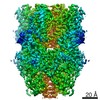 9615MC M: map data used to model this data C: citing same article ( |
|---|---|
| Similar structure data |
- Links
Links
- Assembly
Assembly
| Deposited unit | 
|
|---|---|
| 1 |
|
- Components
Components
| #1: Protein | Mass: 88903.672 Da / Num. of mol.: 4 Source method: isolated from a genetically manipulated source Source: (gene. exp.)   #2: Chemical | ChemComp-NA / #3: Chemical | ChemComp-Y01 / #4: Chemical | ChemComp-LPP / Has protein modification | Y | |
|---|
-Experimental details
-Experiment
| Experiment | Method: ELECTRON MICROSCOPY |
|---|---|
| EM experiment | Aggregation state: PARTICLE / 3D reconstruction method: single particle reconstruction |
- Sample preparation
Sample preparation
| Component | Name: Mouse TRPC5 / Type: COMPLEX / Entity ID: #1 / Source: RECOMBINANT |
|---|---|
| Source (natural) | Organism:  |
| Source (recombinant) | Organism:  |
| Buffer solution | pH: 7.5 |
| Specimen | Embedding applied: NO / Shadowing applied: NO / Staining applied: NO / Vitrification applied: YES |
| Vitrification | Cryogen name: ETHANE |
- Electron microscopy imaging
Electron microscopy imaging
| Experimental equipment | 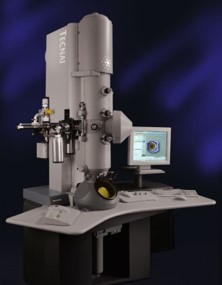 Model: Tecnai Polara / Image courtesy: FEI Company |
|---|---|
| Microscopy | Model: FEI POLARA 300 |
| Electron gun | Electron source:  FIELD EMISSION GUN / Accelerating voltage: 300 kV / Illumination mode: FLOOD BEAM FIELD EMISSION GUN / Accelerating voltage: 300 kV / Illumination mode: FLOOD BEAM |
| Electron lens | Mode: BRIGHT FIELD |
| Image recording | Electron dose: 42.3 e/Å2 / Film or detector model: GATAN K2 IS (4k x 4k) |
- Processing
Processing
| Software | Name: PHENIX / Version: 1.11.1_2575: / Classification: refinement | ||||||||||||||||||||||||
|---|---|---|---|---|---|---|---|---|---|---|---|---|---|---|---|---|---|---|---|---|---|---|---|---|---|
| EM software | Name: PHENIX / Category: model refinement | ||||||||||||||||||||||||
| CTF correction | Type: PHASE FLIPPING AND AMPLITUDE CORRECTION | ||||||||||||||||||||||||
| Symmetry | Point symmetry: C4 (4 fold cyclic) | ||||||||||||||||||||||||
| 3D reconstruction | Resolution: 2.89 Å / Resolution method: FSC 0.143 CUT-OFF / Num. of particles: 1164065 / Num. of class averages: 340465 / Symmetry type: POINT | ||||||||||||||||||||||||
| Refine LS restraints |
|
 Movie
Movie Controller
Controller











 PDBj
PDBj